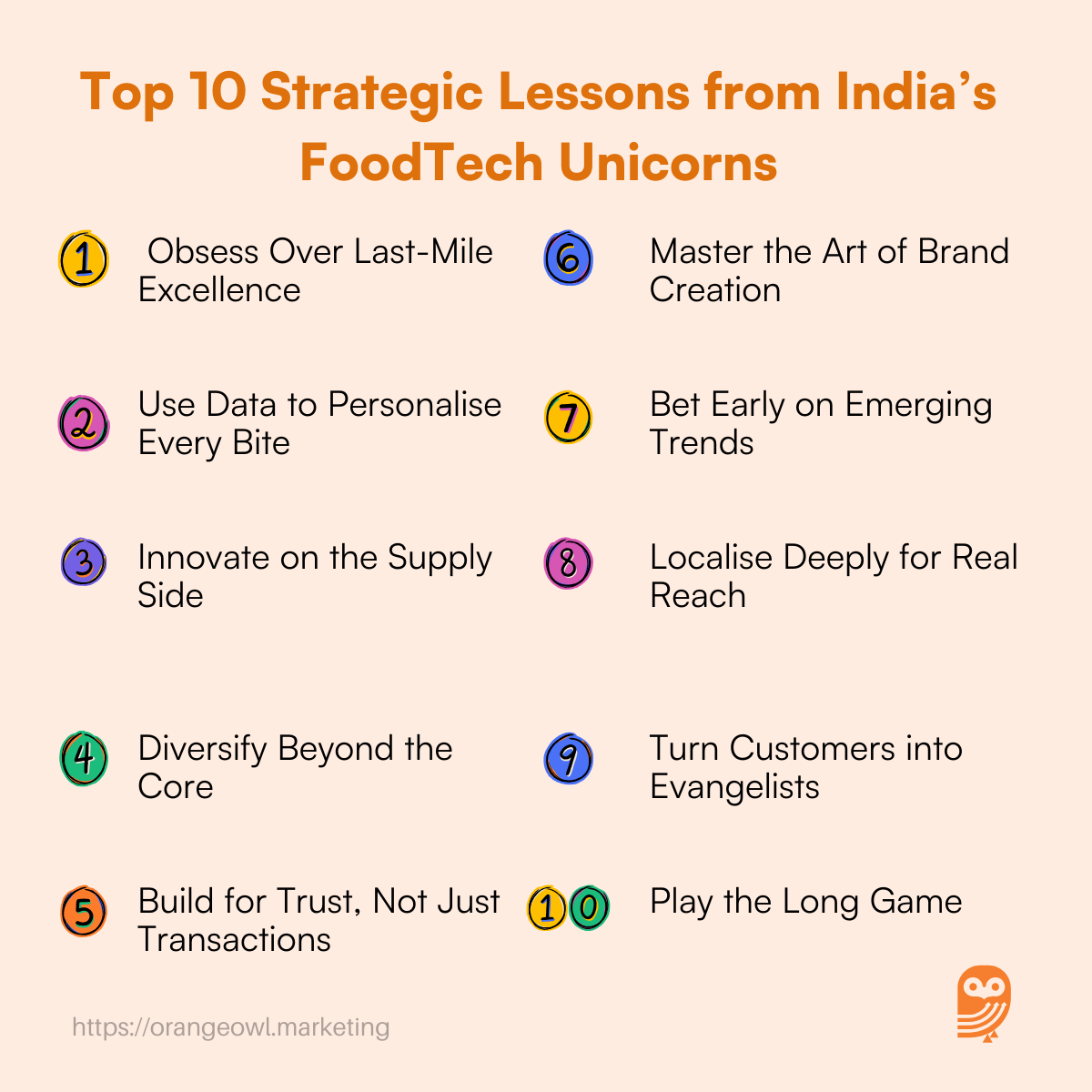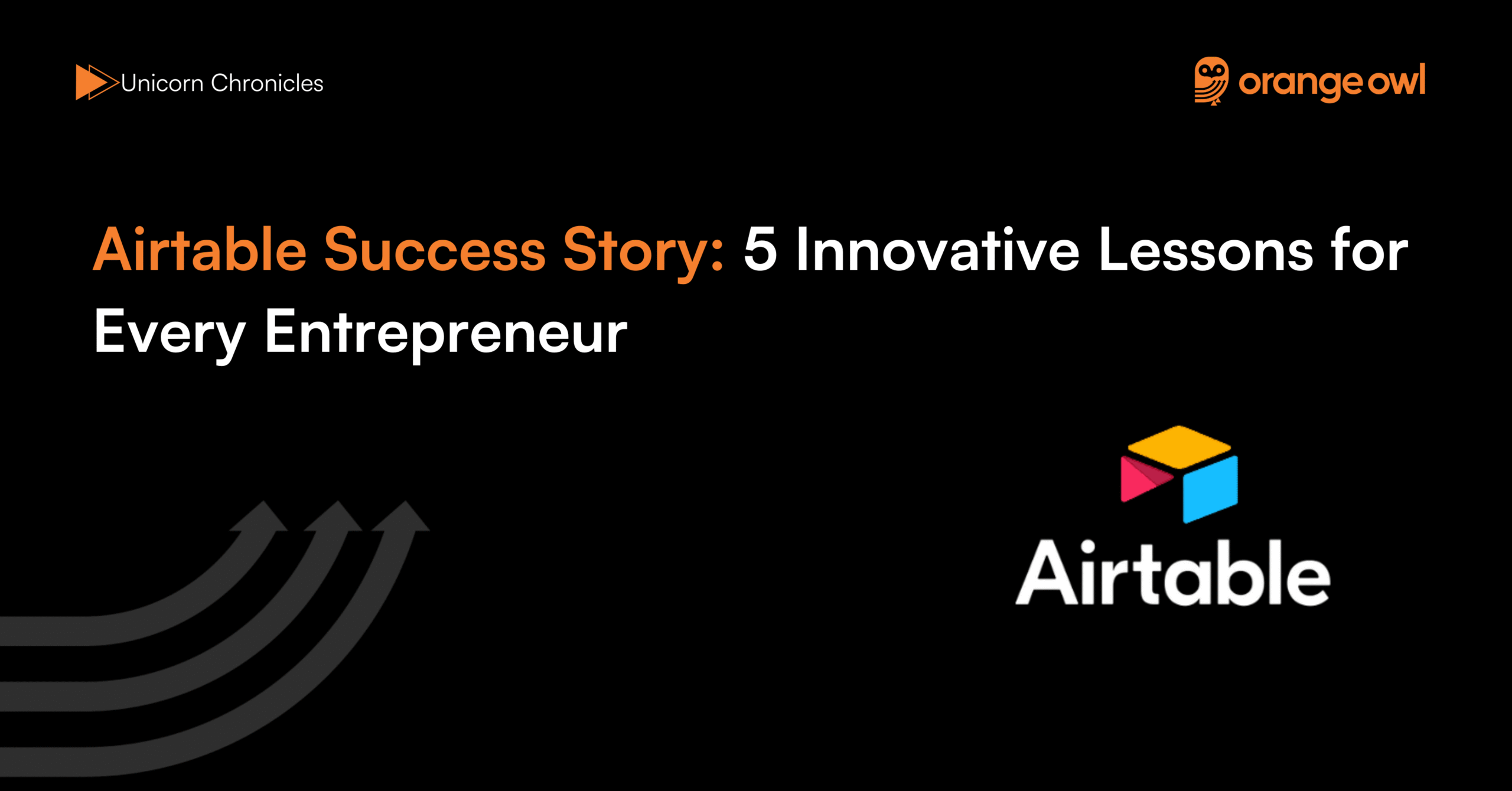Top 10 Strategic Lessons from India’s FoodTech Unicorns
Vivek Goel
June 14, 2025

Table of Contents
Introduction
India’s FoodTech revolution has been nothing short of extraordinary. From occasional pizza deliveries to daily digital dining, the way India eats has been fundamentally reshaped in the last decade. As urban lifestyles evolved and smartphone penetration deepened, food delivery transformed from a convenience to a necessity.
At the centre of this shift are three Indian unicorns that didn’t just build businesses—they rewired consumer behaviour: Zomato, Swiggy, and Rebel Foods. Each of them solved different pieces of the food puzzle—discovery, delivery, and cloud kitchens—but together, they built an ecosystem that now feeds millions daily.
We recently chronicled their inspiring journeys in detail:
🍽️ Zomato Success Story: 5 Strategic Lessons for Every Entrepreneur
🚴 Swiggy Success Story: 5 Lessons from India’s Delivery Giant
🔥 Rebel Foods Success Story: 5 Key Lessons from the Cloud Kitchen King
This blog distils 10 high-impact lessons from their journeys—insights that can help any entrepreneur, in or outside the food industry, think more strategically, scale more sustainably, and serve customers better.
1. Obsess Over Last-Mile Excellence
Swiggy knew early that food delivery isn’t about the app—it’s about logistics. While competitors outsourced fleets, Swiggy built its delivery network from scratch, giving it control over speed, reliability, and user experience.
This ownership meant they could fine-tune delivery ETAs, build incentive systems for partners, and introduce features like live tracking and “Swiggy Genie.” Zomato eventually followed suit, but Swiggy’s early bet on logistics gave it a defensible edge.
✅ Lesson: In any hyperlocal business, owning the last mile lets you
- Ensure quality and consistency
- Deliver faster than competitors
- Experiment with differentiated services
- Build trust through predictable performance
2. Use Data to Personalise Every Bite
Rebel Foods isn’t just a kitchen operator—it’s a data company. With every order, it learns user preferences, time-of-day patterns, and city-level cuisine trends. These insights drive menu design, pricing, and marketing across its 45+ brands.
Zomato uses similar data to tweak restaurant recommendations, show time-sensitive discounts, and even help new restaurants launch with predictive analytics.
✅ Lesson: Data isn’t an add-on—it’s your secret sauce. Use it to
- Optimise SKUs and reduce waste
- Personalise offers based on order history
- Predict demand spikes and plan inventory
- Launch new verticals with high success rates
3. Innovate on the Supply Side
While most startups focus on acquiring customers, Rebel Foods flipped the script by rebuilding the supply chain. Its cloud kitchen model lets it run multiple brands from a single kitchen, lowering costs and maximising real estate.
This asset-light innovation helped it scale to 500+ kitchens across 70+ cities with minimal capex compared to traditional restaurant chains.
✅ Lesson: Innovation isn’t just product-side. You can gain massive leverage by
- Rethinking how your supply chain operates
- Using shared infrastructure to scale faster
- Building backend tech to control quality at scale
- Creating “virtual brands” to unlock new revenue
4. Diversify Beyond the Core
Zomato started with restaurant listings. Swiggy with a food delivery service. But both expanded fast:
- Zomato moved into loyalty programs, events, and delivery
- Swiggy launched Instamart, Swiggy One, and Meat delivery
- Rebel Foods experimented with international licensing and its own proprietary POS
This diversification wasn’t random—it was strategic, leveraging existing users, infrastructure, and data to branch into adjacent high-frequency categories.
✅ Lesson: Once your core engine works, expand into
- Cross-sell opportunities to boost LTV
- High-margin adjacent services
- New formats (subscriptions, quick commerce)
- Ecosystem features to increase stickiness
5. Build for Trust, Not Just Transactions
Food is emotional. Hygiene, freshness, and safety matter. Zomato understood this early and invested in trust-building: verified photos, hygiene ratings, customer reviews, transparent delivery times, and prompt customer support.
Rebel Foods built SOPs to ensure standardisation across its brands, with centralised monitoring systems and kitchen audits.
✅ Lesson: In high-frequency categories like food:
- Trust = retention
- Consistency beats creativity
- Transparency builds loyalty
- Experience matters as much as price

6. Master the Art of Brand Creation
Rebel Foods didn’t just cook food—it built brands. From Faasos to Behrouz Biryani to Oven Story, each brand had its own identity, story, and audience, even though the food came from the same kitchen.
This approach unlocked repeatability and targeted marketing, allowing them to run hyper-specific campaigns across demographics and occasions.
✅ Lesson: In a commoditised space, brand equity matters.
- Create sub-brands to target niches
- Use storytelling to drive emotional resonance
- Build scalable templates to launch new brands fast
- Reinforce differentiation in a crowded market
7. Bet Early on Emerging Trends
Swiggy doubled down on quick commerce through Instamart, anticipating India’s shift toward instant gratification. Zomato launched Hyperpure to tap into B2B food supplies. Rebel Foods built a full-stack kitchen OS and was early to cloud kitchens, long before they became buzzwords.
These moves weren’t reactive—they were vision-led bets on what the next consumer behaviour wave might look like.
✅ Lesson: Don’t wait for trends to mature. To lead, you must
- Listen to early signals from user behaviour
- Back bold ideas with fast experiments
- Use existing infrastructure to de-risk innovation
- Stay ahead by thinking 2–3 years out
8. Localise Deeply for Real Reach
Swiggy and Zomato both invested in vernacular support, regional cuisines, and local festival tie-ins. This wasn’t just marketing—it was a growth strategy.
Rebel Foods launched city-specific brands and menus (e.g., Lucknowi Biryani, Bengali Bowls) based on local demand, increasing adoption in Tier 2 and Tier 3 cities.
✅ Lesson: India is not one market. To scale, you must
- Offer hyper-local menus and pricing
- Adapt branding to local tastes and language
- Partner with regional influencers
- Run local activations for cultural resonance
9. Turn Customers into Evangelists
Zomato pioneered food storytelling—photos, reviews, curated lists—long before social media was mainstream in India. This created a community-driven discovery loop, where users sold the product to each other.
Swiggy used delightful marketing, tweet replies, and meme campaigns to build share-worthy moments, while Rebel Foods created strong digital loyalty programs and UGC campaigns.
✅ Lesson: Your best marketers are your users. Empower them by
- Incentivising reviews and shares
- Building fun, relatable social content
- Creating communities and referral programs
- Celebrating users in-app and on social
10. Play the Long Game
All three unicorns faced brutal challenges:
- Pandemic disruptions
- High burn and operational complexity
- Fundraising winters and regulatory scrutiny
But they persisted with pivots, partnerships, and product innovation. Zomato went public. Swiggy expanded horizontally. Rebel Foods became the world’s largest internet restaurant company. Their resilience wasn’t reactive—it was baked into their DNA.
✅ Lesson: Scaling a food business isn’t a sprint. It’s a marathon. You must
- Balance growth with unit economics
- Invest in culture and process early
- Reinvent often to stay relevant
- Think long-term while executing short-term
Conclusion
Zomato, Swiggy, and Rebel Foods didn’t just ride the food delivery wave—they designed the surfboards. Their stories are a playbook in product-market fit, operational execution, and consumer psychology.
Whether you’re building a FoodTech startup or a D2C brand, these 10 lessons remind us that great businesses aren’t just built—they’re cooked with care, innovation, and long-term flavour.
✅ If there’s one final takeaway, it’s this:
Feed your users with value, spice it with personalisation, and serve it with trust—and you’ll build a brand they’ll keep coming back to.


